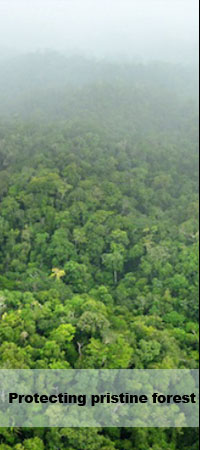|
The ravaging of French Guyana isn’t exactly hitting the front pages of newspapers and online news-links these days, but the environmental devastation of yet another small equatorial country adds to the 150 year-old onslaught of the planet under the guise of human “progress”.
The size of Portugal and bordered by Brazil and Surinam, French Guyana has a population of about 250,000 people. Bordered by Brazil and Surinam, 90% of its landmass is covered by one of the most pristine rainforests in the world. Its diverse indigenous people groups include the Taino (Arawak), Galibi and Palikur on the coast, and the Emerillon, Oyampi and Wayana in the interior.
Including French Guyana, the Amazon basin has been subjected to small-scale, informal, and illegal mining for decades. In French Guyana alone, illegal gold mining has extended deep into pristine rainforests. Let’s be statistically graphic here: used to separate gold from ore, 1.3 kilograms of mercury is required to recover only 1 kilogram of gold. We estimate that 1.5 to 2 tons of mercury is released each year into the environment, with more than 300 tons having been released since the beginning of this century. This is massive in at least three ways: in such amounts mercury seriously damages the ecosystems, pollutes all nearby waterways, and can deform and even kill all forms of life downstream from jungle mining sites. The Guyana Shield rainforest is the largest remaining tropical forest still relatively intact, but, due to uncontrolled gold mining, in the last 20 years it has become the primary contributor to environmental degradation in the region, and represents a serious ongoing threat to all indigenous tribes.
About 800 illegal gold mining sites have been identified in 2013, with most of them being active. Mining and other forms of environmental stressors pollute about 200 kilometers of streams and rivers, have devastated at least 1,200 hectares of deforested areas, and have increased the degradation of many other vulnerable habitats. Despite recent but inadequate measures against illegal gold mining, the French government has failed to curb these crimes against the rainforests, its incredible biodiversity, and the indigenous peoples.
Impacts on Indigenous Peoples
As mentioned above, indigenous peoples are impacted heavily by illegal gold mining. Due to the high content of mercury and methyl-mercury in river streams, a transfer from mercury through microbiological activity has rendered many stretches of rivers no longer suitable for fishing and bathing. Indigenous peoples must restrict their eating to fewer and fewer fish species because there’s less mercury present in the lower levels of the food chain. An interval of between 50 and 180 days is needed to eliminate tolerable amounts of mercury from the average human body. But as shown by comprehensive studies done on mercury poisoning of indigenous peoples in other countries, including Canada, if a human fetus is contaminated, the health consequences are irreversible: proven deformities to the central nervous system and physical development may occur as the concentration of mercury increases.
Wildlife Decline due to Contamination
Birds and mammals that eat fish along rivers are exposed to methyl-mercury. Similarly, predators that eat fish-eating animals are at risk. In the recent past, methyl mercury has been found in eagles, otters, and endangered Florida panthers. The exposure to methyl mercury in wildlife can result in high mortality rates, reduced fertility, slower growth and development, and abnormal behaviors that affect their natural interactions and therefore survival in their natural habitat. For instance, with a current total wild population estimated at between 1,000 and 5,000, the giant otter (Pteronura brasiliensis) is particularly at risk because of its high consumption of fish. The largest of the 13 otter species, it’s endemic to the rainforests and wetlands of South America, and the effects of methyl mercury on these beautiful creatures and others is potentially unstoppable should mercury’s effects continue to spread.
In addition, research studies indicate that the endocrine system of fish - which plays an important role in fish development and reproduction - may be altered by the levels of methyl mercury found in the environment. Past studies have shown that concentration of mercury in along eight rivers in French Guyana ranged from .24mg/kg to .48 mg/kg (0.03-1.53) for carnivorous fish and .05 mg/kg (0.001 - 0.68) for herbivorous fish. Although not yet thoroughly investigated, it seems obvious that mercury has to be affecting the unique biodiversity of the Amazon.
As well, other forms of wildlife are rapidly declining in many areas due to the illegal hunting by miners. Not only do miners compete over the same food resources as indigenous peoples, but they also bring disease and crime (e.g., stealing river boats, prostitution) into the rainforest.
Where are the French Government and European Union?
As an integral part of France, French Guyana is part of the European Union and the Eurozone, even to the extent that its currency is the Euro. But in French Guyana, French and European laws are not clearly enforced by the French government to stop illegal mining in “protected areas” that represent 47 percent of the territory. Such activities would not be tolerated in Europe: the French Government must face its responsibility and significantly increase the number of army and police patrols by which to enforce strict laws that would put illegal miners behind bars. After all, as the territory was the penal colony for France for centuries, surely the same stringent enforcement measures can be applied to miscreant miners, loggers and hunters.
What can You Do?
Join us to ensure that the French government multiplies the numbers of patrol forces in the region by
Join us to advocate that the French government provides stronger law enforcement that includes protected areas where unlicensed miners, loggers and hunters can continue their illegal activities with impunity. At present, when their camps are destroyed, knowing police enforcement to be under-manned and poorly resourced, they will wait and make another camp later on, perhaps on the same site. For example, in Surinam, the country adjacent to French Guyana, illegal gold mining is less rampant because of more effective and stronger law enforcement.
Do not buy new items made from gold. Gold mining is one of the most damaging industries in the Third World where corruption tends to reign, where to the environment is under extreme pressure by such practices, and where the destruction of rainforests, the polluting of rivers with cyanide and mercury, and in some cases where the displacement of indigenous people is prevalent and irreversible.
|
|
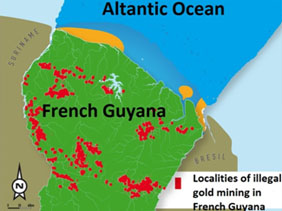
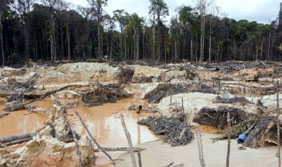
Illegal mining site found in French Guyana. © Jody Amiet. AFP
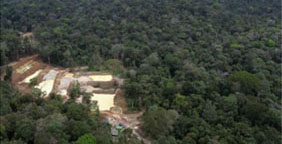
Aerial view of an illegal mining site in French Guyana. © 2minutes
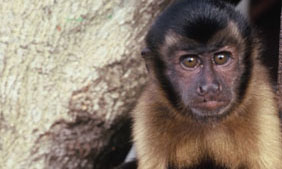
Primates are heavily impacted by gold mining. © Endangered Species International
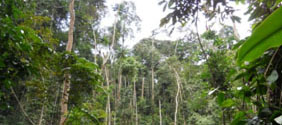
Rainforest must be protected from illegal godl mining © Endangered Species International
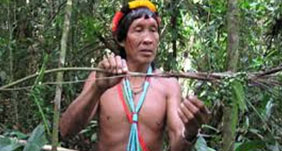
A Wayana indigenous person from French Guyana © AFP
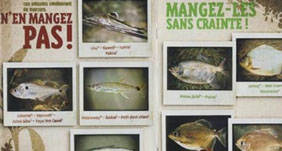
Freshwater fishes which can’t be consumed due to their high mercury content in French Guyana.
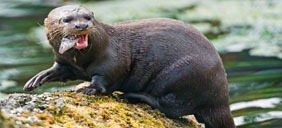
The giant otter can reach up 7 meters. © Tambako the Jaguar.
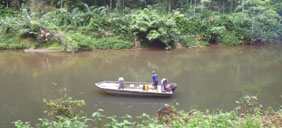
Habitat of the giant otter. © Endangered Species International
|

